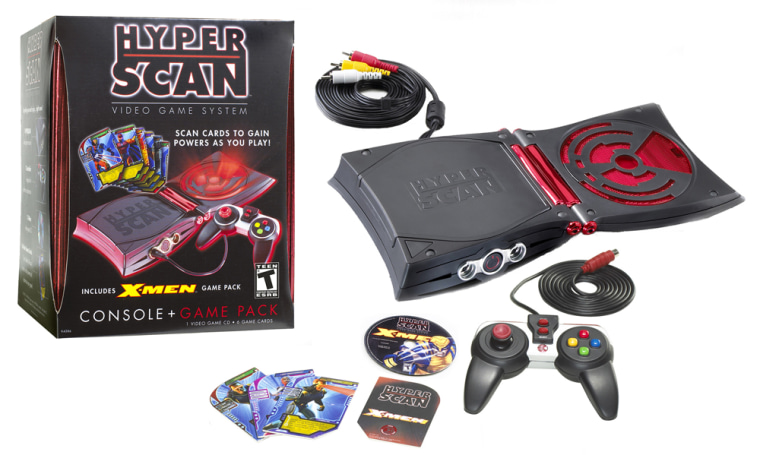The holiday season is shaping up to be a mighty battle between three state-of-the-art game consoles. And then there's Mattel Inc.'s HyperScan, a minor-league entry that seeks to carve a niche by combining a console with something else boys are known to like: collectible cards.
Six cards are included with the small, light game console, and more can be bought separately in booster packs, much like Yu-Gi-Oh or baseball cards. When scanned into the console, the cards give the player access to game characters and powers.
It's a nifty idea, particularly since the hardware doesn't cost that much: The console is $70, including an X-Men fighting game on a CD and one controller.
That's a lot less than the latest generation of game consoles. Sony Corp.'s PlayStation 3, due next month, will cost $499 and up, while Nintendo Co.'s Wii will set you back $249.
But the difference in the quality of game graphics is even greater than the price suggests. Judging by the X-Men game, HyperScan is barely up to the level of the first PlayStation, which came out a decade ago. It doesn't render three-dimensional environments at all, a striking concept in an industry that spends billions on developing more powerful 3-D processing chips.
Graphics aren't everything, though. Games can be perfectly enjoyable in 2-D. But it does mean that even boys 8 to 12 years old — HyperScan's target market — will know that it's way down on the game console pecking ladder.
On the other hand, the HyperScan could be the top of the collectible-card game ladder. Other collectible card games are played on a table or floor, with no electronic enhancement (though there is a baseball game with cards that are scanned by LeapFrog Enterprises Inc.'s FLY pen, which contains a talking computer).
The HyperScan's cards are much thicker than regular collectible cards — they're almost as thick as the cover of a hardback book.
That thickness provides room for a radio-frequency identification (RFID) chip, which can be read by holding the card about a third of an inch from the scanning area of the console. The same kind of chips are already in use in security cards, in anti-theft systems and for tracking shipping pallets. They're broadly seen as the future replacement for barcodes.
The HyperScan cards are a little smarter than most RFID chips, because they have memory. For instance, to play the Wolverine character in the X-Men game, you scan in the Wolverine card. When you use him in a fight, Wolverine's skills improve. After the fight, scan the card again, and his new experience level is stored on the card.
That means that you can bring your improved Wolverine card over to your friend's house and use it on his console, to fight his character. That portability is probably the coolest thing about the card concept, and it compensates somewhat for the lack of online play capability.
The card's memory also means you can't evaluate a used character card just by looking at it: you have to scan it into the console to see how much stored experience it has. That's an impediment to the lunchroom and school-corridor trading that fuels interest in the other collectible cards.
That's one reason it's hard to see the HyperScan becoming a big phenomenon. Another obstacle is that the cards with extra characters and powers are expensive, at $10 for a booster pack of six. Also, there are only 102 cards planned for the X-Men game, a number that's unlikely to lure collectors away from the Magic or Yu-Gi-Oh lines, each of which has thousands of unique cards.
The HyperScan also gives parents a mixed message. It's clearly something for tweens, but the box is rated T for Teen because of the violent content of the X-Men game, which is a fairly pedestrian clone of "Mortal Kombat." Mattel is clearly counting on parents to ignore that rating. The two other games that are out, "Ben 10" and "Interstellar Wrestling League," are rated for age 10 and up. They sell for $20.
Final recommendation: If your kids will settle for a cheap console, you're probably better off with a previous generation Sony, Nintendo or Microsoft box. If they're into collectible card games, they'd probably do better with one of the bigger systems.
If they really want a HyperScan, well, then I can't help you.
